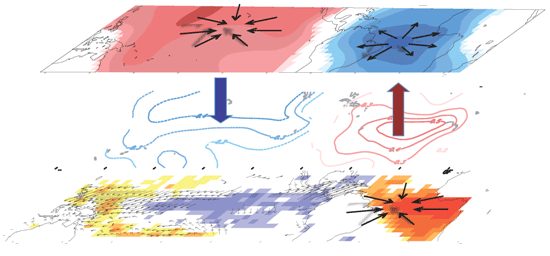The Teleconnection of the Tropical Atlantic to Indo-Pacific Sea Surface Temperatures on Inter-Annual to Centennial Time Scales: A Review of Recent Findings
Abstract
:1. Introduction
2. Observational Data, Model, and Experimental Set-Up and Methodology
3. Results
3.1. Interannual Tropical Atlantic-Pacific Teleconnection
3.1.1. Atlantic Niño
3.1.2. North Tropical Atlantic-Pacific Teleconnection
3.1.3. Assessment of Forcing from ATL3 and NTA
3.1.4. Multidecadal Variations of the Interannual Atlantic-Pacific Connection
3.2. Multidecadal Atlantic-Pacific Teleconnection
3.3. Centennial Atlantic-Pacific Teleconnection
4. Discussion and Conclusions
Acknowledgments
Author Contributions
Conflicts of Interest
References
- Ropelewski, C.P.; Halpert, M.S. Global and regional scale precipitation associated with the El Niño/Southern Oscillation. Mon. Weather Rev. 1987, 115, 1606–1626. [Google Scholar] [CrossRef]
- Duan, W.; Wei, C. The “sping predictability barrier” for ENSO predictions and its possible mechanism: results from a fully coupled model. Int. J Clim. 2012, 33, 1280–1292. [Google Scholar] [CrossRef]
- Chen, D.; Cane, M.A.; Kaplan, A.; Zebiak, Z.E.; Huang, D. Predictability of El Niño over the past 148 years. Nature 2004, 428, 733–736. [Google Scholar] [CrossRef] [PubMed]
- Rodriguez-Fonseca, B.; Polo, I.; Garcia-Serrano, J.; Losada, T.; Mohino, E.; Mechoso, C.R.; Kucharski, F. Are Atlantic Niños enhancing Pacific ENSO events in recent decades? Geophys. Res. Lett. 2009, 36, L20705. [Google Scholar] [CrossRef]
- Wang, C.; Kucharski, F.; Barimalala, R.; Bracco, A. Teleconnections of the tropical Atlantic to the tropical Indian and Pacific Oceans: A review of recent findings. Meteorol. Z. 2009, 18, 445–454. [Google Scholar] [CrossRef]
- Ding, H.; Keenlyside, N.S.; Latif, M. Impact of the Equatorial Atlantic on the El Niño Southern Oscillation. Clim. Dyn. 2012, 38, 1965–1972. [Google Scholar] [CrossRef] [Green Version]
- Frauen, C.; Dommenget, D. Influences of the tropical Indian and Atlantic Oceans on the predictability of ENSO. Geophys. Res. Lett. 2012, 39, L02706. [Google Scholar] [CrossRef]
- Jansen, M.F.; Dommenget, D.; Keenlyside, N.S. Tropical Atmosphere-Ocean Interactions in a Conceptual Framework. J. Clim. 2009, 22, 550–567. [Google Scholar] [CrossRef]
- Polo, I.; Martin-Rey, M.; Rodriguez-Fonseca, B.; Kucharski, F.; Mechoso, C.R. Processes in the Pacific La Niña onset triggered by the Atlantic Niño. Clim. Dyn. 2014, 44, 115–131. [Google Scholar] [CrossRef]
- Martin-Rey, M.; Polo, I.; Rodriguez-Fonseca, B.; Kucharski, F. Changes in the inter-annual variability of the tropical Pacific as a response to an equatorial Atlantic forcing. Sci. Mar. 2012, 76. [Google Scholar] [CrossRef]
- Martin-Rey, M.; Rodriguez-Fonseca, B.; Polo, I.; Kucharski, F. On the Atlantic-Pacific Niños connection: A multidecadal modulated mode. Clim. Dyn. 2014, 43. [Google Scholar] [CrossRef]
- Martin-Rey, M.; Rodriguez-Fonseca, B.; Polo, I. Atlantic opportunities for ENSO prediction. Geophys. Res. Lett. 2015, 42, 6802–6810. [Google Scholar] [CrossRef]
- Keenlyside, N.S.; Ding, H.; Latif, M. Potential of equatorial Atlantic variability to enhance El Niño prediction. Geophys. Res. Lett. 2013, 40, 2278–2283. [Google Scholar] [CrossRef] [Green Version]
- Ham, Y.-Y.; Kug, J.-S.; Park, J.Y.; Jin, F.-F. Sea surface temperature in the north tropical Atlantic as a trigger for El NiÃśo/Southern Oscillation events. Nat. Geosci. 2013, 6. [Google Scholar] [CrossRef]
- Ham, Y.-Y.; Kug, J.-S.; Park, J.Y.; Jin, F.-F. Two distinct roles of Atlantic SSTs in ENSO variability: North tropical Atlantic SST and Atlantic Niño. Geophys. Res. Lett. 2013, 40, 4012–4017. [Google Scholar] [CrossRef]
- Kucharski, F.; Syed, F.S.; Burhan, A.; Farah, I.; Gohar, A. Tropical Atlantic influence on Pacific variability and mean state in the twentieth century in observations and CMIP5. Clim. Dyn. 2014, 44. [Google Scholar] [CrossRef]
- Sasaki, W.; Doi, T.; Richards, K.J.; Masumoto, Y. Impact of the equatorial Atlantic sea surface temperature on the tropical Pacific in a CGCM. Clim. Dyn. 2014, 43, 2539–2552. [Google Scholar] [CrossRef]
- Dong, B.W.; Sutton, R.T. Enhancement of El Niño-Southern Oscillation (ENSO) variability by a weakened Atlantic thermohaline circulation in a coupled GCM. J. Cliamte 2007, 20, 4920–4939. [Google Scholar] [CrossRef]
- Lu, R.; Chen, W.; Dong, B. How does a weakened Atlantic thermohaline circulation lead to an intensification of the ENSO-south Asian summer monsoon interaction? Geophys. Res. Lett. 2008, 35, L08706. [Google Scholar] [CrossRef]
- Timmermann, A.; Okumura, Y.; An, S.-I.; Clement, A.; Dong, B.; Guilyardi, E.; Hu, A.; Jungclaus, J.H.; Renold, M.; Stocker, T.F.; et al. The influence of a weakening of the Atlantic Meridional overturning circulation on ENSO. J. Clim. 2007, 20, 4899–4919. [Google Scholar] [CrossRef]
- Zhang, R.; Delworth, T.L. Impact of the Atlantic multidecadal oscillation on north pacific climate variability. Geophys. Res. Lett. 2007, 34, L23708. [Google Scholar] [CrossRef]
- Kucharski, F.; Ikram, F.; Molteni, F.; Farneti, F.; Kang, I.-S.; No, H.H.; King, M.P.; Giuliani, G.; Mogensen, K. Atlantic forcing of Pacific decadal variability. Clim. Dyn. 2015. [Google Scholar] [CrossRef]
- Meehl, G.A.; Hu, A.; Santer, B.D. The mid-1970s climate shift in the Pacific and the relative roles of forced versus inherent decadal variability. J. Clim. 2009, 22, 780–792. [Google Scholar] [CrossRef]
- Graham, N.E. Decadal-scale climate variability in the tropical and North Pacific during the 1970s and 1980s: Observations and model results. Clim. Dyn 1994, 10, 135–162. [Google Scholar] [CrossRef]
- Dong, B.; Lu, R. Interdecadal Enhancement of the Walker Circulation over the Tropical Pacific in the Late 1990s. Adv. Atmos. Sci. 2013, 30, 247–262. [Google Scholar] [CrossRef]
- Miller, A.J.; Cayan, D.R.; Barnett, T.P.; Graham, N.E.; Oberhuber, J.M. Interdecadal variability of the Pacific Ocean: model response to observed heat fluxes and wind stress anomalies. Clim. Dyn. 1994, 9, 187–302. [Google Scholar] [CrossRef]
- England, M.H.; McGregor, S.; Spence, P.; Meehl, G.A.; Timmermann, A.; Cai, W.; Gupta, A.S.; McPhaden, M.J.; Purich, A.; Santoso, A. Recent intensification of wind- driven circulation in the Pacific and the ongoing warming hiatus. Nat. Clim. Change 2014, 4, 222–227. [Google Scholar] [CrossRef]
- Kosaka, Y.; Xie, S.-P. Recent global-warming hiatus tied to equatorial Pacific surface cooling. Nature 2013, 501, 403–407. [Google Scholar] [CrossRef] [PubMed]
- Trenberth, K.E.; Fasullo, J.T. An apparent hiatus in global warming? Earth’s Future 2013, 1, 19–32. [Google Scholar] [CrossRef]
- Kang, I.-S.; No, H.-H.; Kucharski, F. ENSO Amplitude Modulation Associated with the Mean SST Changes in the Tropical Central Pacific Induced by Atlantic Multidecadal Oscillation. J. Clim. 2014, 27, 7911–7920. [Google Scholar] [CrossRef]
- McGregor, S.; Timmermann, A.; Stuecker, M.F.; England, M.H.; Merrifield, M.; Jin, F.-F.; Chikamoto, Y. Recent Walker circulation strengthening and Pacific cooling amplified by Atlantic warming. Nat. Clim. Change 2014, 4. [Google Scholar] [CrossRef]
- Li, X.; Xie, S.-P.; Gille, S.T.; Yoo, C. Atlantic-induced pan-tropical climate change over the last three decades. Nat. Clim. Change 2015. [Google Scholar] [CrossRef]
- Chikamoto, Y.; Kimoto, M.; Watanabe, M.; Ishii, M.; Mochizuki, T. Relationship between the Pacific and Atlantic stepwise climate change during the 1990s. Geophys. Res. Lett. 2012, 39. [Google Scholar] [CrossRef]
- Chikamoto, Y.; Timmermann, A.; Luo, J.-J.; Mochizuki, T.; Kimoto, M.; Watanabe, M.; Ishii, M.; Xie, S.-P.; Jin, F.-F. Skilful multi-year predictions of tropical trans-basin climate variability. Nat. Commun. 2015, 6. [Google Scholar] [CrossRef] [PubMed]
- Farneti, R.; Molteni, F.; Kucharski, F. Pacific interdecadal variability driven by tropical-extratropical interactions. Clim. Dyn. 2014, 42, 3337–3355. [Google Scholar] [CrossRef]
- Farneti, R.; Dwivedi, S.; Kucharski, F.; Molteni, F.; Griffies, S.M. On Pacific Subtropical Cell Variability over the Second Half of the Twentieth Century. J. Clim. 2014, 27, 7102–7112. [Google Scholar] [CrossRef]
- Kucharski, F.; Kang, I.-S.; Farneti, R.; Feudale, L. Tropical Pacific response to 20th century Atlantic warming. Geophys. Res. Lett. 2011, 38, L03702. [Google Scholar] [CrossRef]
- Vecchi, G.A.; Clement, A.; Soden, B.J. Examining the tropical Pacific’s response to global warming. EOS Trans. AGU 2008, 89. [Google Scholar] [CrossRef]
- Rayner, N.A.; Parker, D.E.; Horton, E.B.; Folland, C.K.; Alexander, L.V.; Rowell, D.P.; Kent, E.C.; Kaplan, A. Global analyses of sea surface temperature, sea ice, and night marine air temperature since the late nineteenth century. J. Geophys. Res. 2003, 108. [Google Scholar] [CrossRef] [Green Version]
- Compo, G.P.; Whitaker, J.S.; Sardeshmukh, P.D.; Matsui, N.; Allan, R.J.; Yin, X.; Gleason, B.E.; Vose, R.S.; Rutledge, G.; Bessemoulin, P.; et al. The 20th century reanalysis project. Q. J. R. Meteorol. Soc. 2011, 137, 1–28. [Google Scholar] [CrossRef]
- Carton, J.A.; Giese, B. A Reanalysis of Ocean Climate Using Simple Ocean Data Assimilation (SODA). Mon. Weather Rev. 2008, 136, 2999–3017. [Google Scholar] [CrossRef]
- SODA: Simple Ocean Data Assimilation. Available online: https://climatedataguide.ucar.edu/climate-data/soda-simple-ocean-data-assimilation (accessed on 7 November 2014).
- Kucharski, F.; Molteni, F.; King, M.P.; Farneti, R.; Kang, I.S.; Feudale, L. On the need of intermediate complexity general circulation models. BAMS 2013, 94, 25–30. [Google Scholar] [CrossRef]
- Madec, G. NEMO Ocean Engine; Note du Pole de modalisation, Institut Pierre-Simon Laplace (IPSL): Paris, France, 2008; Volume 27, 1288–1619. [Google Scholar]
- Valcke, S. OASIS3 User Guide (prism_2-5); CERFACS Technical Report 2006 TR/CMGC/06/73, PRISM Report No 3; CERFACS: Toulouse, France, 2006; p. 60. [Google Scholar]
- Fichefet, T.; Morales Maqueda, M.A. Sensitivity of a global sea ice model to the treatment of ice thermodynamics and dynamics. J. Geophys. Res. 1997, 102, 12609–12646. [Google Scholar] [CrossRef]
- Kroeger, J.; Kucharski, F. Sensitivity of ENSO characteristics to a new interactive flux correction scheme in a coupled GCM. Clim. Dyn. 2011, 36, 119–137. [Google Scholar] [CrossRef]
- Losada, T.; Rodriguez-Fonseca, B.; Polo, I.; Janicot, S.; Gervois, S.; Chauvin, F.; Ruti, P.M. Tropical response to the Atlantic Equatorial mode: AGCM multimodel approach. Clim. Dyn. 2010, 35, 45–52. [Google Scholar] [CrossRef]
- Ruiz-Barradas, A.; Carton, J.A.; Nigam, S. Structure of inter-annual- to-decadal climate variability in the tropical Atlantic sector. J. Clim. 2000, 13, 3285–3297. [Google Scholar] [CrossRef]
- Losada, T.; Rodriguez-Fonseca, B. Tropical Atmospheric Response to Decadal Changes in the Atlantic Equatorial Mode. Clim. Dyn. 2015. [Google Scholar] [CrossRef]
- Chiang, J.C.H.; Kushnir, Y.; Zebiak, S.E. Interdecadal changes in the eastern Pacific ITCZ variability and its influence on the Atlantic ITCZ. Geophys. Res. Lett. 2000, 27, 3687–3690. [Google Scholar] [CrossRef]
- Parker, D.; Folland, C.; Scaife, A.; Knight, J.; Colman, A.; Baines, P.; Dong, B. Decadal to multidecadal variability and the climate change background. J. Geophys. Res. 2007, 112. [Google Scholar] [CrossRef]
- Trenberth, K.; Shea, D.J. Atlantic hurricanes and natural variability in 2005. Geophys. Res. Lett. 2005, 33. [Google Scholar] [CrossRef]
- Yang, C.; Giese, B.S.; Wu, L. Ocean Dynamics and Tropical Pacific Climate Change in Ocean Reanalyses and Coupled Climate Models. J. Geophys. Res. Oceans 2014, 119. [Google Scholar] [CrossRef]
- Mohino, E.; Rodriguez-Fonseca, B.; Losada, T.; Gervois, S.; Janicot, S.; Bader, J. Changes in the inter-annual SST-forced signals on West African rainfall. AGCM intercomparison. Clim. Dyn. 2011, 37, 1707–1725. [Google Scholar] [CrossRef]
- Rodriguez-Fonseca, B.; Janicot, S.; Mohino, E.; Losada, T.; Bader, J. Interannual and decadal SST-forced responses of the West African monsoon. Atmos. Sci. Lett. 2010, 12, 67–74. [Google Scholar] [CrossRef]
- Torralba, V.; Rodriguez-Fonseca, B.; Mohino, E.; Losada, T. The non-stationary influence of the Atlantic and Pacific Niños on North Eastern South American rainfall. Front. Earth Sci. 2015, 3. [Google Scholar] [CrossRef]
- Losada, T.; Rodriguez-Fonseca, B.; Kucharski, F. Tropical influence on the summer Mediterranean climate. Atmos. Sci. Lett. 2012, 13, 36–42. [Google Scholar] [CrossRef] [Green Version]
- Richter, I.; Xie, S.-P.; Behera, S.K.; Doi, T.; Masumoto, Y. Equatorial Atlantic variability and its relation to mean state biases in CMIP5. Clim. Dyn. 2014, 42, 171–188. [Google Scholar]
- Mechoso, C.R.; Robertson, A.W.; Barth, N.; Davey, M.K.; Delecluse, P.; Gent, P.R.; Ineson, S.; Kirtman, B.; Latif, M.; le Treut, H.; et al. The seasonal cycle over the Tropical Pacific in General Circulation Models. Mon. Weather Rev. 1995, 123, 2825–2838. [Google Scholar] [CrossRef]
- Guilyardi, E.; Bellenger, H.; Collins, M.; Ferrett, S.; Cai, W.; Wittenberg, A. A first look at ENSO in CMIP5. Clivar Exch. 2012, 17, 29–32. [Google Scholar]
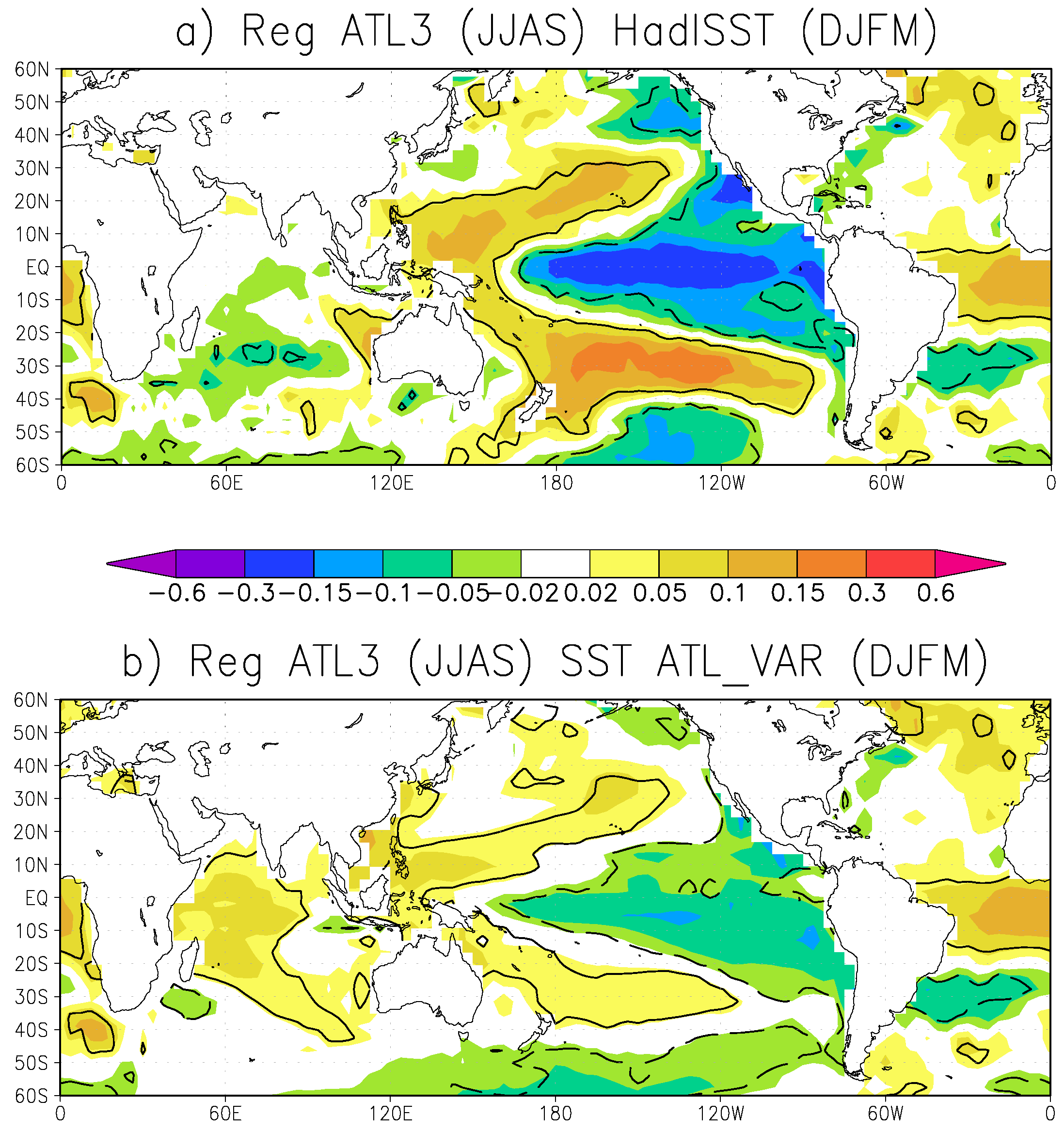
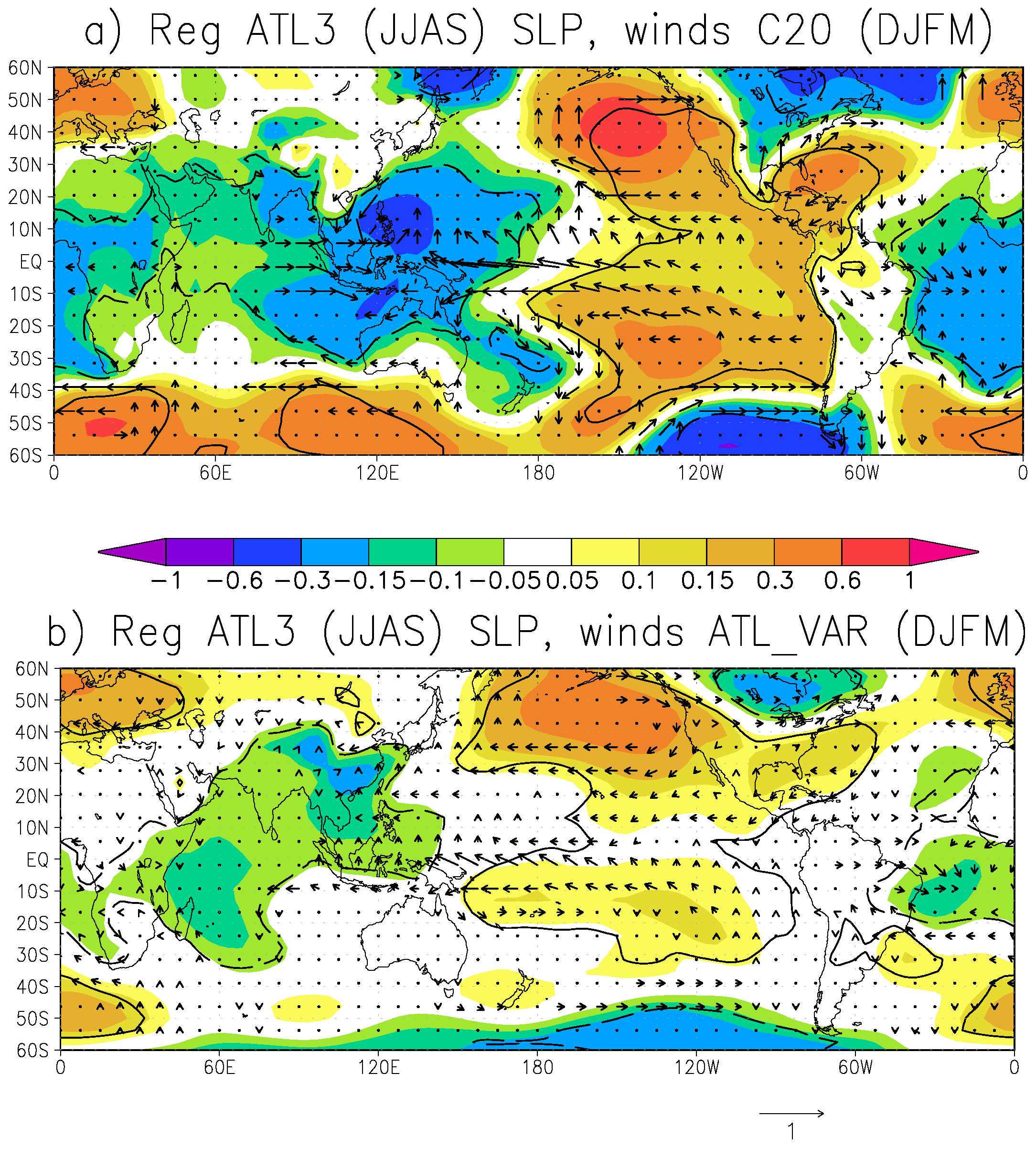
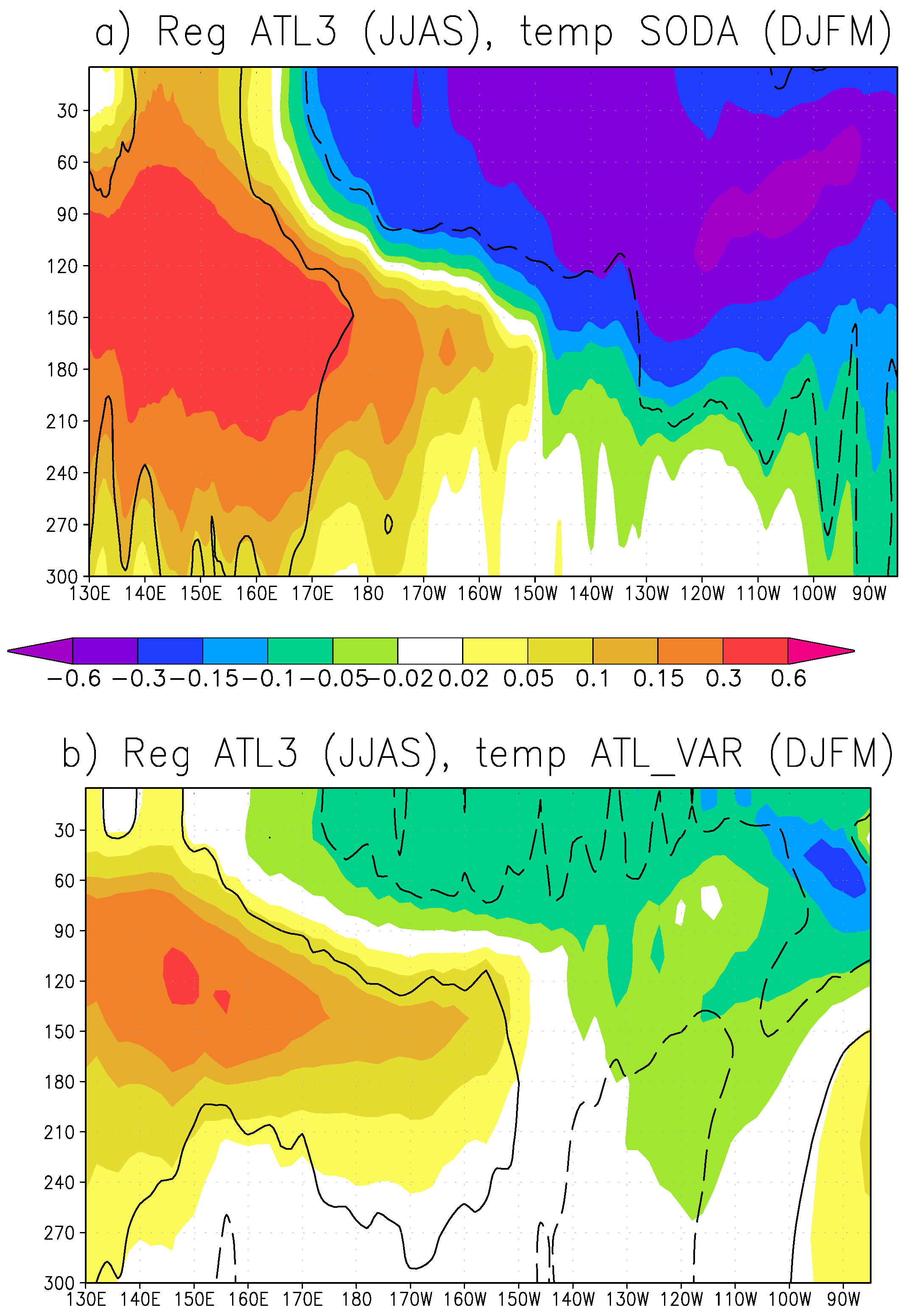
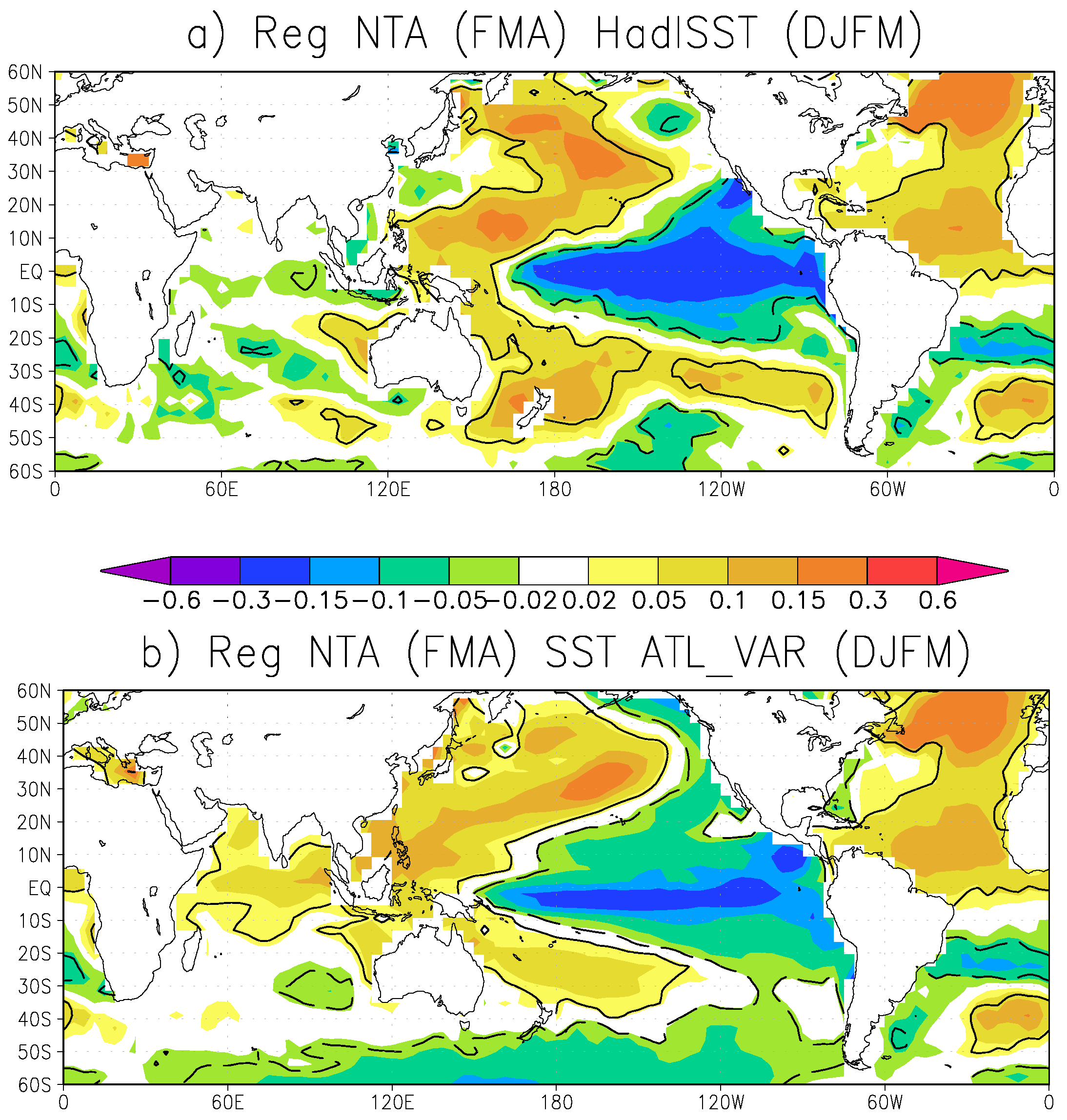
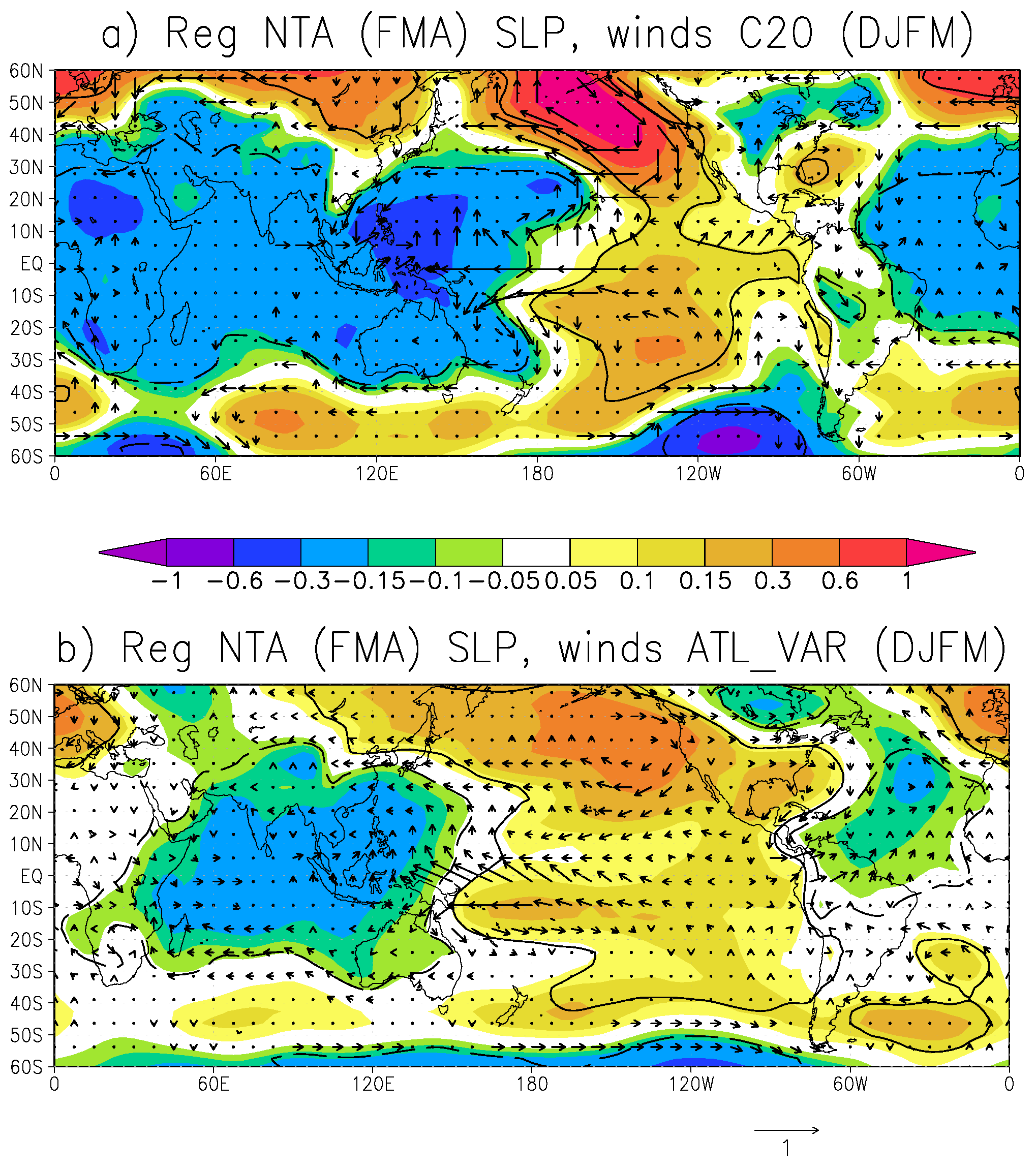

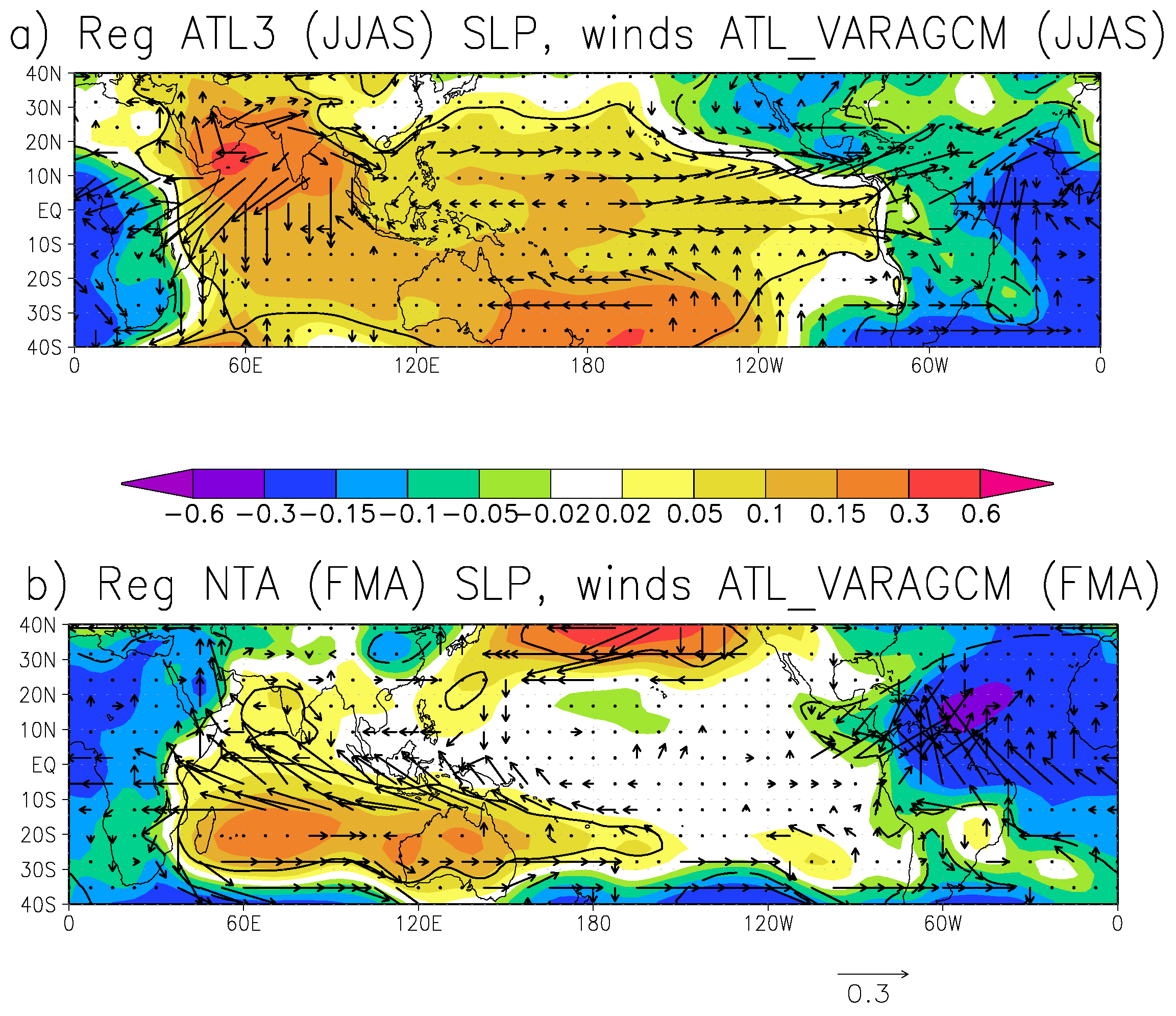
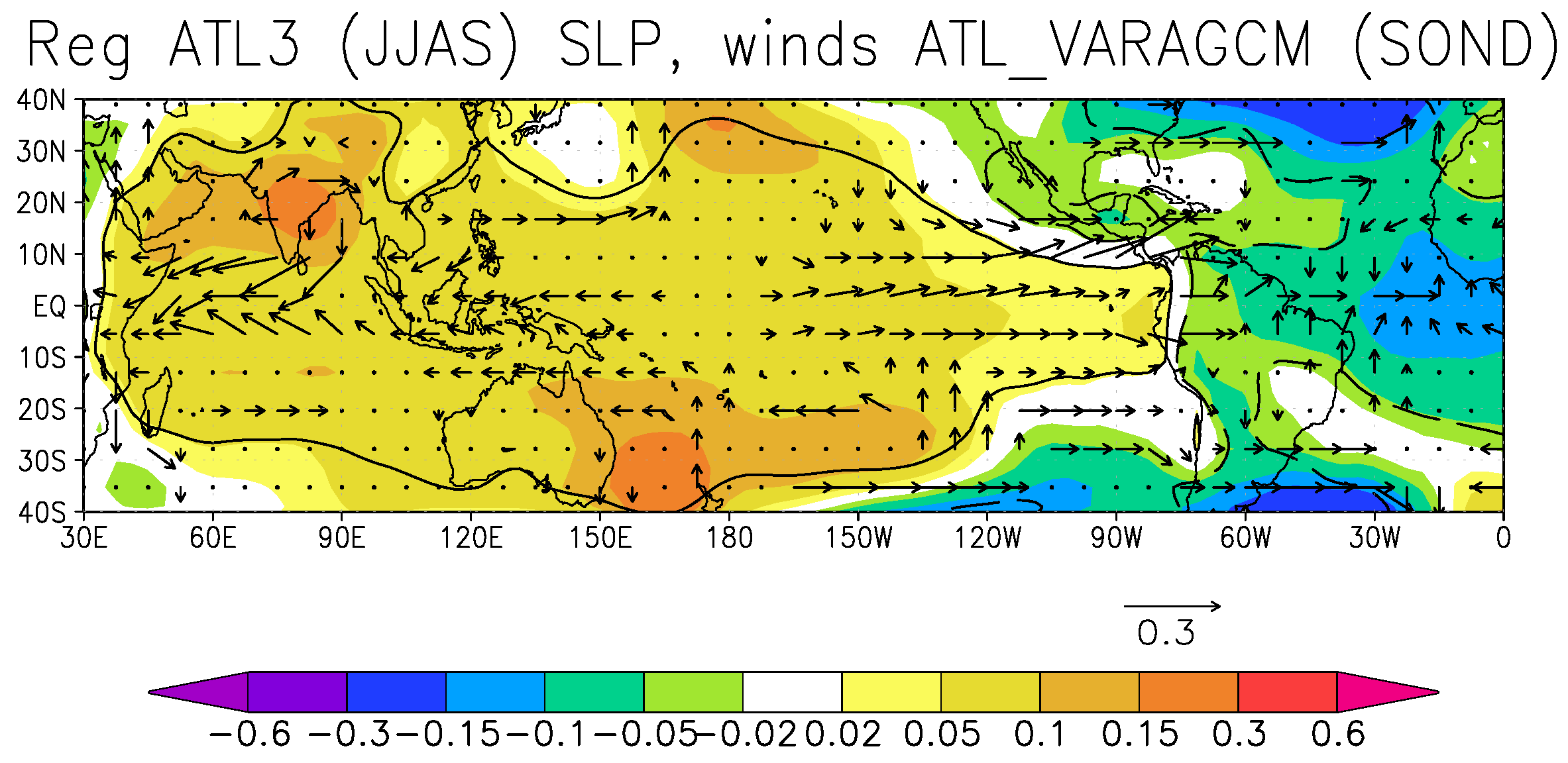
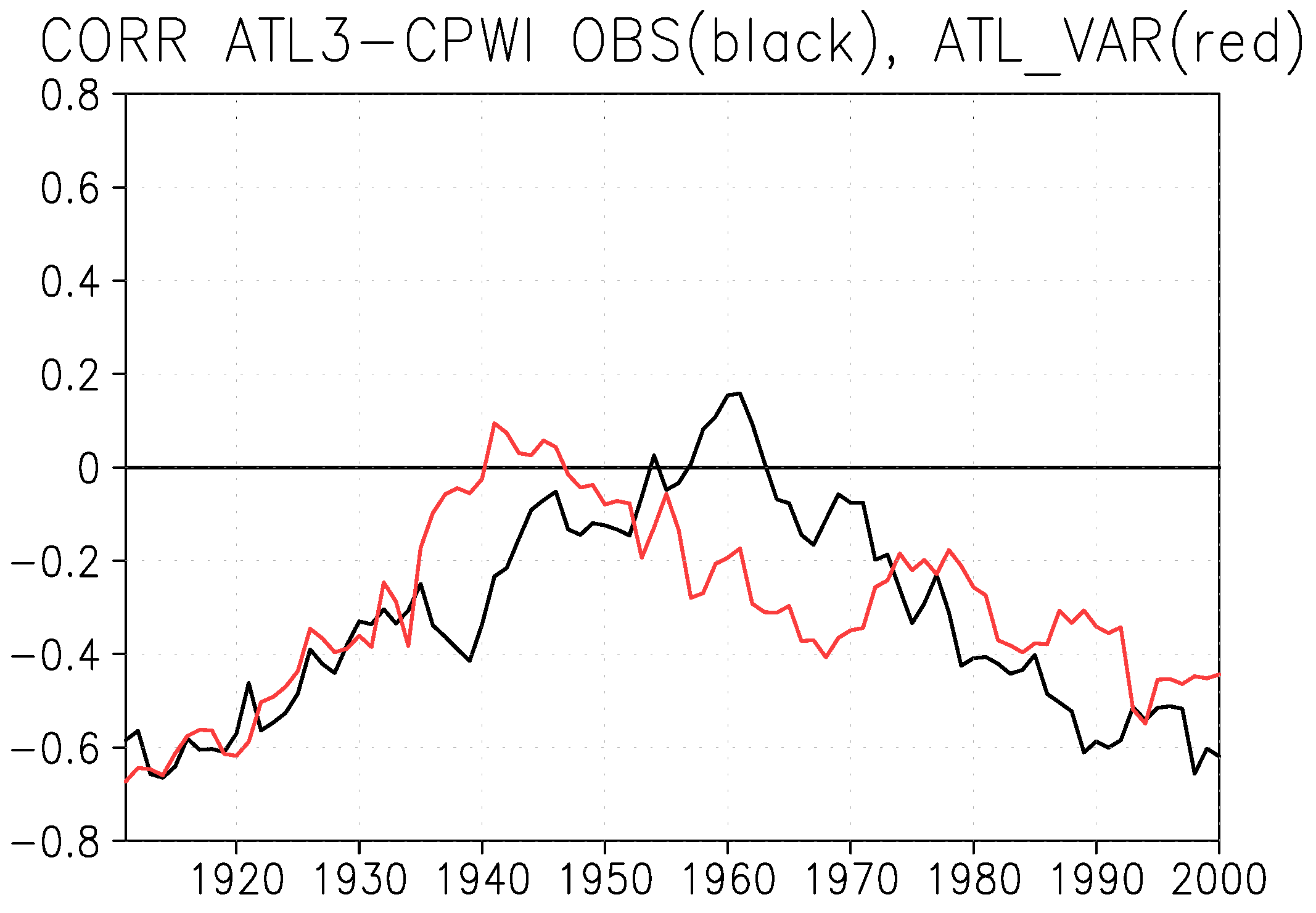
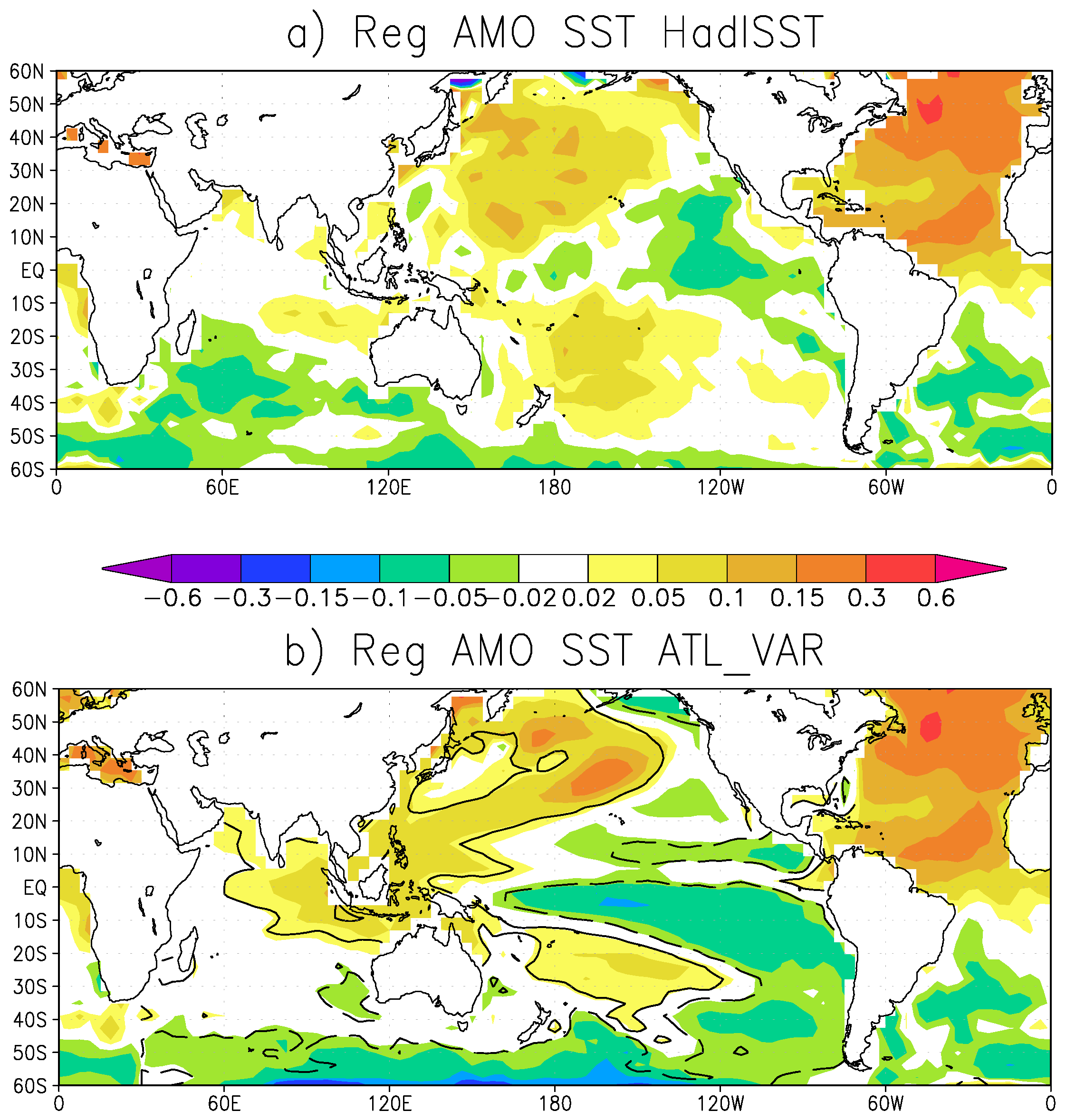
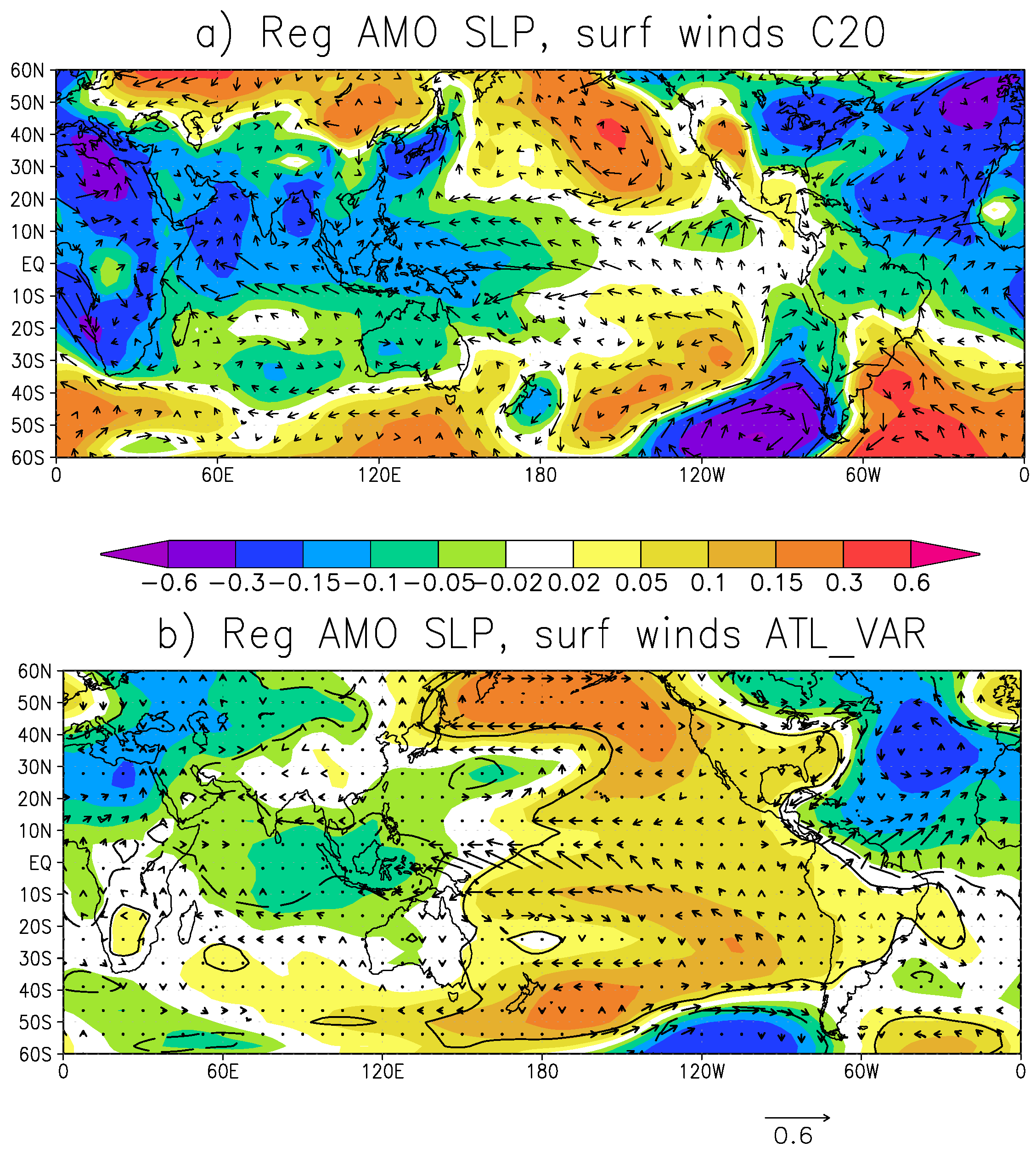
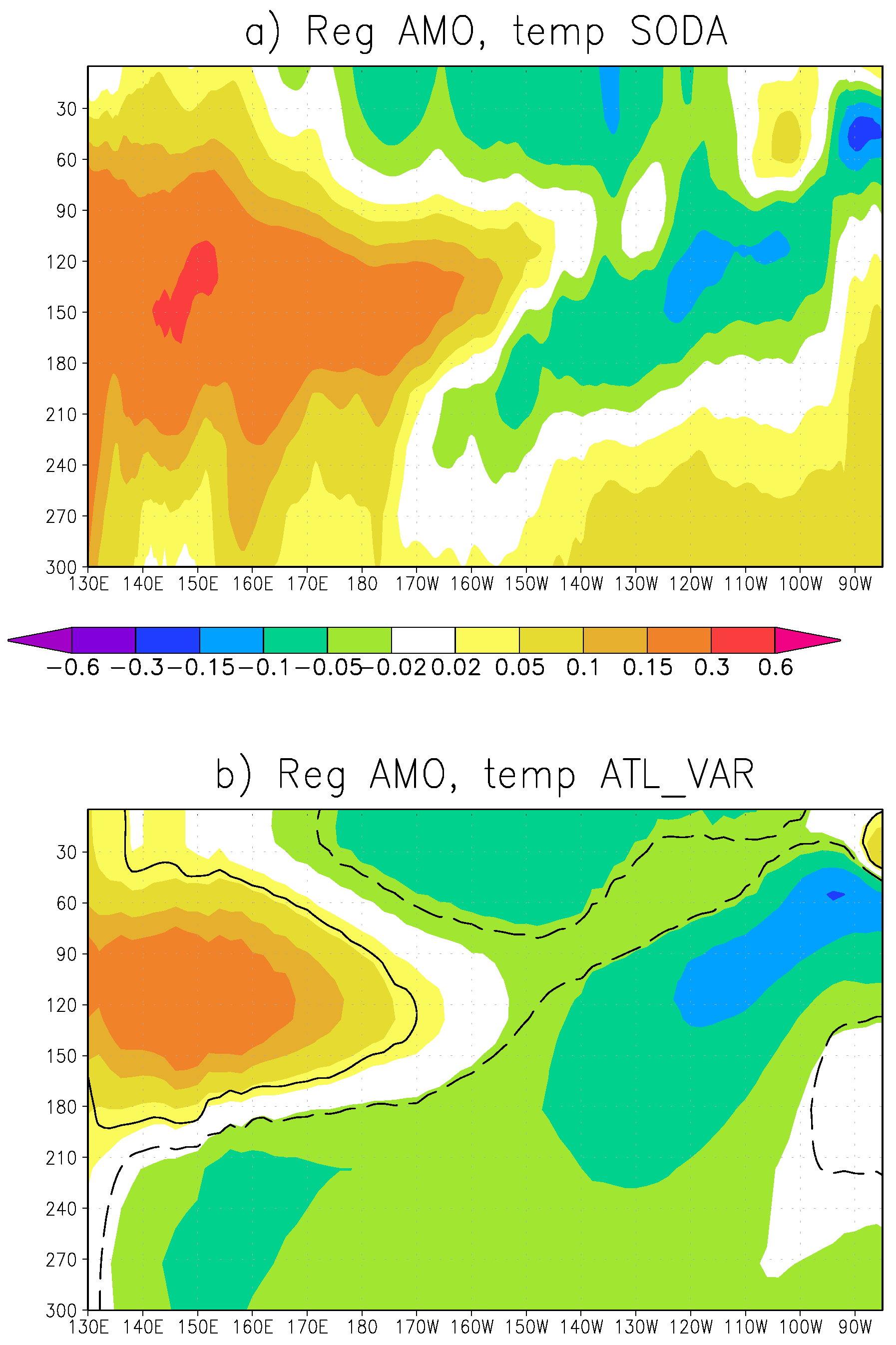
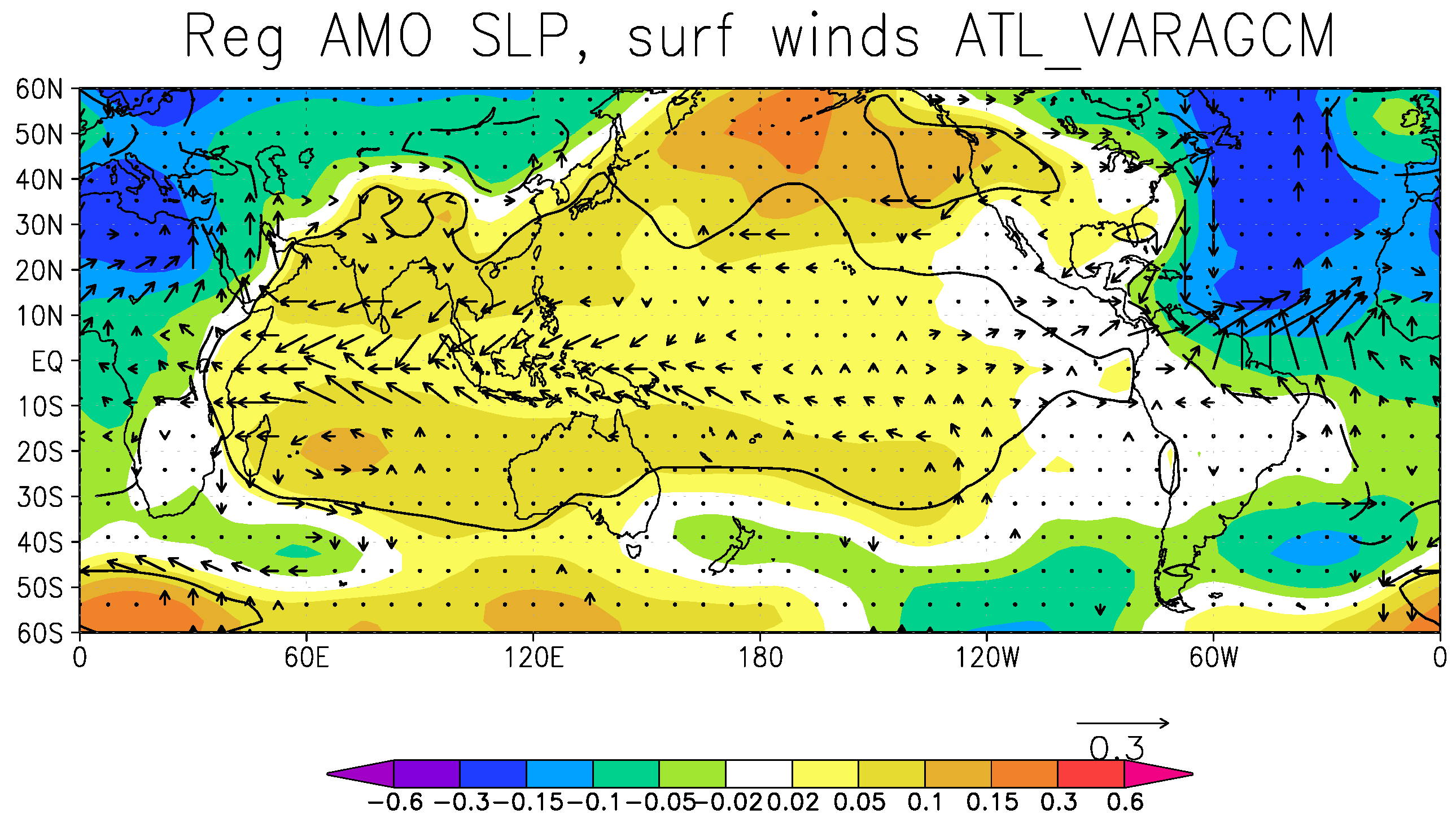

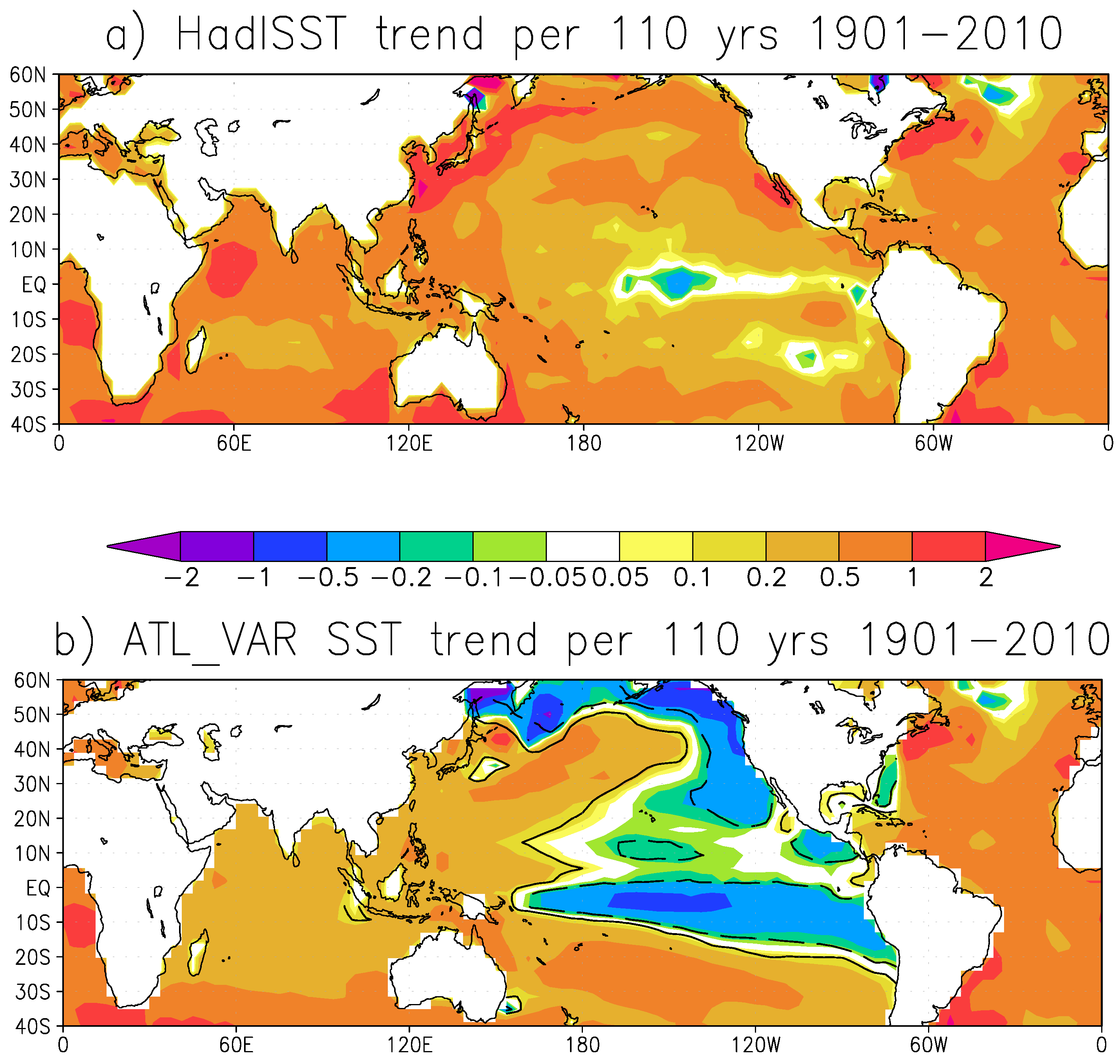
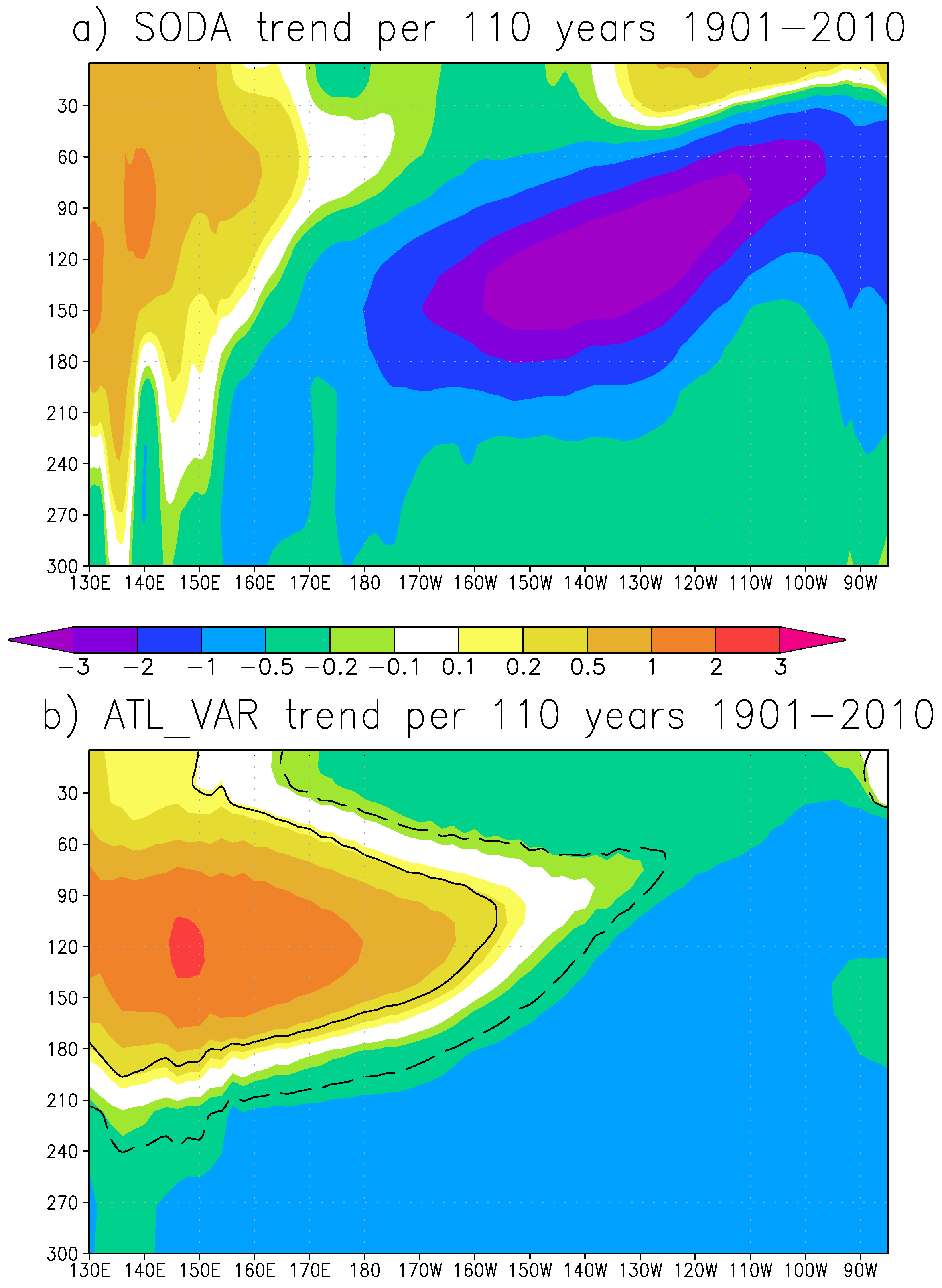
© 2016 by the authors; licensee MDPI, Basel, Switzerland. This article is an open access article distributed under the terms and conditions of the Creative Commons by Attribution (CC-BY) license (http://creativecommons.org/licenses/by/4.0/).
Share and Cite
Kucharski, F.; Parvin, A.; Rodriguez-Fonseca, B.; Farneti, R.; Martin-Rey, M.; Polo, I.; Mohino, E.; Losada, T.; Mechoso, C.R. The Teleconnection of the Tropical Atlantic to Indo-Pacific Sea Surface Temperatures on Inter-Annual to Centennial Time Scales: A Review of Recent Findings. Atmosphere 2016, 7, 29. https://doi.org/10.3390/atmos7020029
Kucharski F, Parvin A, Rodriguez-Fonseca B, Farneti R, Martin-Rey M, Polo I, Mohino E, Losada T, Mechoso CR. The Teleconnection of the Tropical Atlantic to Indo-Pacific Sea Surface Temperatures on Inter-Annual to Centennial Time Scales: A Review of Recent Findings. Atmosphere. 2016; 7(2):29. https://doi.org/10.3390/atmos7020029
Chicago/Turabian StyleKucharski, Fred, Afroja Parvin, Belen Rodriguez-Fonseca, Riccardo Farneti, Marta Martin-Rey, Irene Polo, Elsa Mohino, Teresa Losada, and Carlos R. Mechoso. 2016. "The Teleconnection of the Tropical Atlantic to Indo-Pacific Sea Surface Temperatures on Inter-Annual to Centennial Time Scales: A Review of Recent Findings" Atmosphere 7, no. 2: 29. https://doi.org/10.3390/atmos7020029




